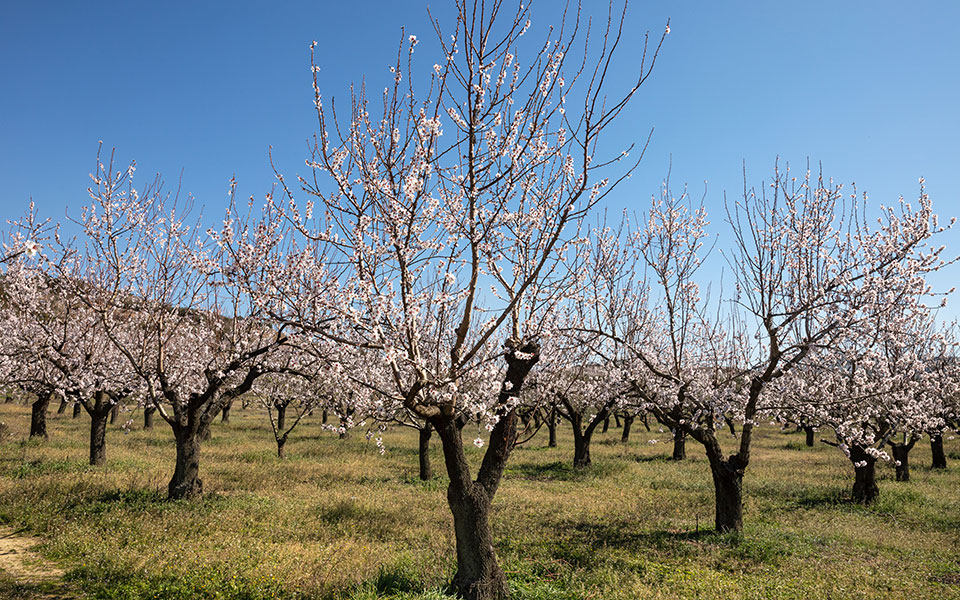In Ofrynio, in Kavala prefecture, on a slope just three kilometers away from the Strymonian Gulf, the morning March sun showers the blossoming almond trees, lined up as if on parade. The strong light touches the white petals and is reflected onto the grass, creating the illusion that there are no shadows. The light is so intense, it appears that the trees are momentarily floating above the grass. A discreet scent imbues the air, while the only sound is the buzzing of bees flitting from flower to flower to draw the early nectar. As you look around, you think this is the spot that spring has picked to stage its annual premiere. And rightly so.
According to mythology, Demophon of Athens, son of Theseus, was shipwrecked in Thrace after the Trojan War and subsequently met Phyllis, daughter of King Sithon. When he left for Athens and delayed his return for their marriage, the beautiful girl was overcome by despair and, to save her from death, the gods transformed her into an almond tree. Demophon returned in the winter in search of his beloved and, upon seeing the tree without leaves, made a sacrifice in the gods’ honor to appease her spirit. At that moment, in the middle of winter, the almond tree blossomed to reciprocate the feelings of love, and has since become a timeless symbol of hope – for a love that conquers death.
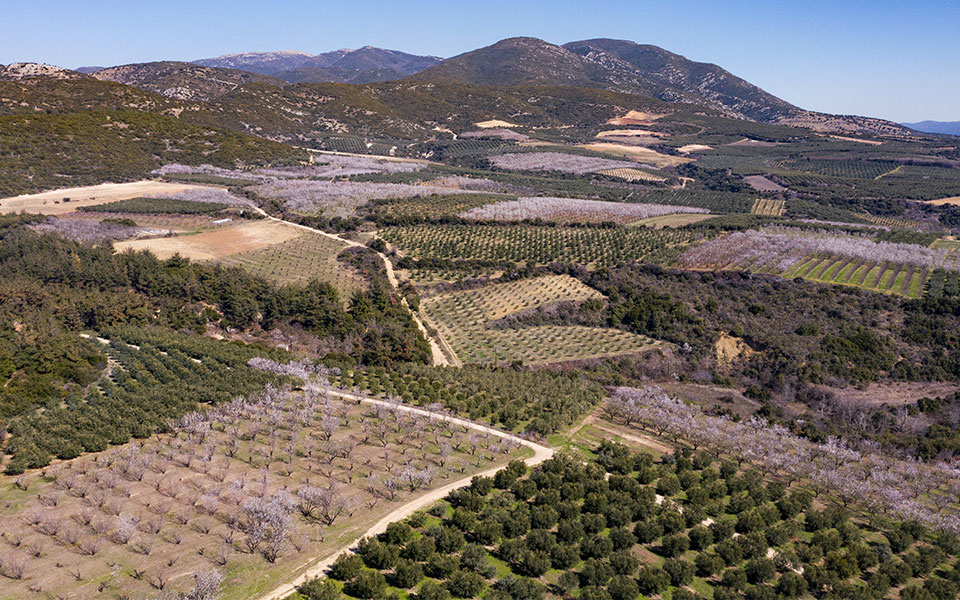
© Konstantinos Tsakalidis/SOOC
A refugee village with an ancient history
Ofrynio is located west of Kavala, on the foothills of the Pangaion Hills, literally perched atop a 70 to 100-meter incline. Its approximately 800 inhabitants are mostly descendants of refugees from Ofrynio in Asia Minor, modern-day Erenköy in Turkey, which they say was located about 11 kilometers from ancient Troy. Until 1954, when it was renamed, the village was called Kato Lakkovikia.
There are various archaeological sites scattered around the outskirts of the village, which are not open to the public, that indicate this area was inhabited from prehistoric times; for instance, the ruins of the ancient city of Eion, discovered at the location of Profitis Ilias, south of Ofrynio. The city was a colony of ancient Eretria and a seaport for Amphipolis, which, via the River Strymonas, reached Lake Achinou (ancient Kerkinitida). The lake was drained dry in 1936 to create arable land for the refugee population from Asia Minor, expelled following the Greco-Turkish War (1919-1922).
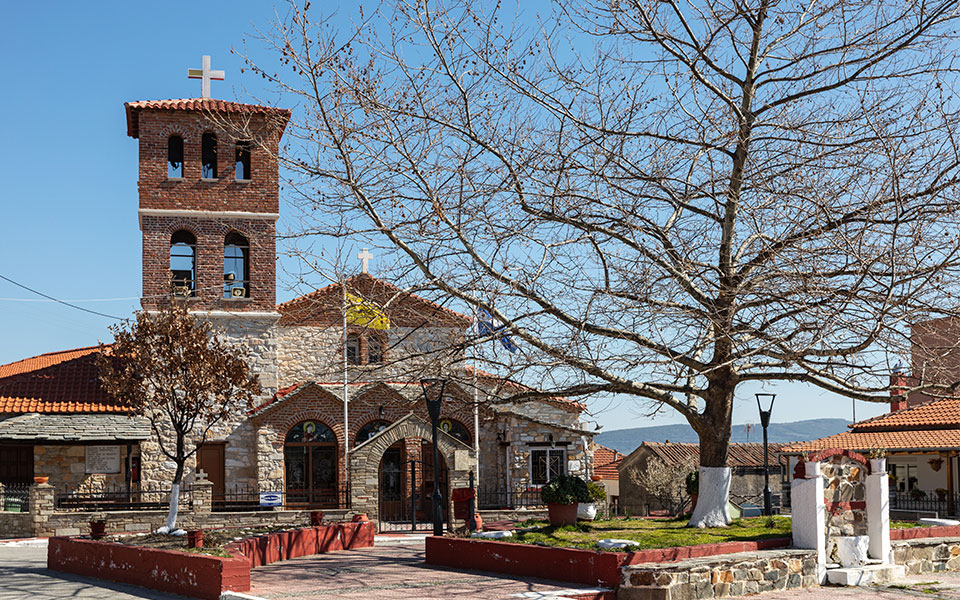
© Konstantinos Tsakalidis/SOOC
In the village, where Greek flags fly from almost every balcony, few traces of the refugee past remain. This is essentially a developing settlement and, due to its modern history, did not have a traditional architectural style to preserve. The roads are wide, the cement-paved yards are loaded with the usual staples – wood, jars of olives, cans of oil, crates of fruits and vegetables – and some red-tile roofs are lined with photovoltaic panels.
In the central square, the imposing Church of Aghios Georgios reminds people of the beloved patron saint of displaced persons, whose icon was taken to the church of the same name in Nikaia in Piraeus, where the majority of refugees from the original Ofrynio settled. “Half the inhabitants of Ofrynio are called Giorgos, in honor of the saint,” says Giorgos Epitropou in a self-deprecating way.
An almond producer born and raised in Ofrynio, he continues a family tradition handed down from generation to generation. Now aged 49, he remembers growing up among these almond trees and describes the mass watering of the trees in the summer with a tangible nostalgia. Today, the memories of his three children are rather different. “In the past, there was no one in the village who did not own almond trees. Now, you meet many people who are not involved in the production of almonds, as they prefer olives.”
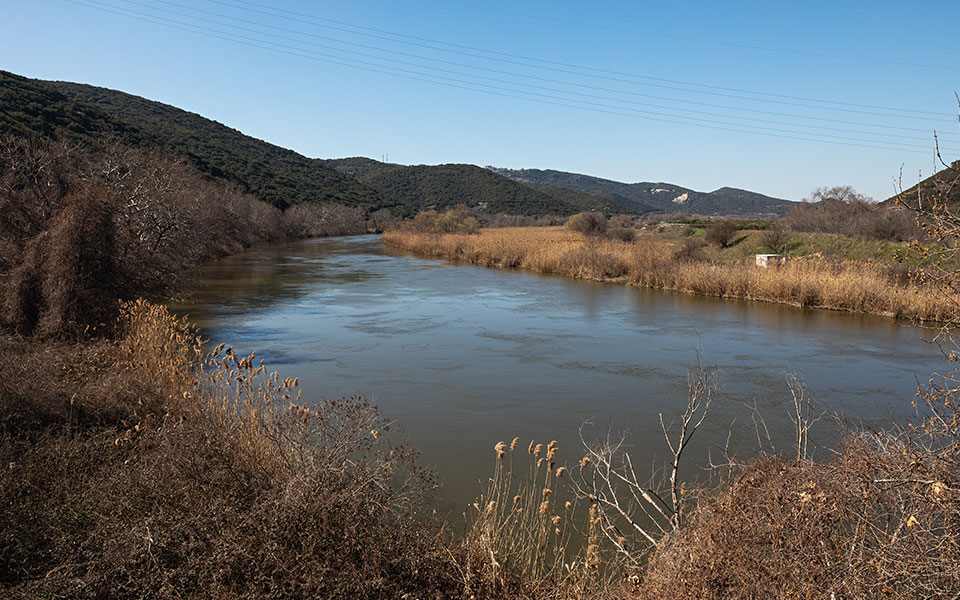
© Konstantinos Tsakalidis/SOOC
The aura of the Strymonas
In fact, the view from the small incline where we stand, behind one of the two biggest almond crushing machines in the wider region, is indicative of the shifting emphasis on olive cultivation. The half a hectare of almond trees before us, some of which were planted more than five decades ago, are surrounded by olive groves. Some feature newly planted olive trees, others are already bearing fruit. This encapsulates the entire setting: tidy orchards of almond trees surrounded by large expanses of olive trees.
As Epitropou explains, the systematic turn towards the production of Halkidiki olives began in 2000, as the yield of this “green gold” was almost 2.5 times greater. “And most importantly, the production of olives is not tiresome, it is much easier and has a more stable yield in comparison with almonds,” he adds, with the former estuary of the Strymonas in the background, which has developed into a veritable marine ecosystem for flamingoes and many species of sea birds.
Yet the Strymonian Gulf, which extends from Asprovalta to the small port of Kariani, includes the traditional almond-producing villages of Amphipoli, with its famed archaeological museum, the martyred village of Nea Kerdilia, Mesolakkia in Serres, Galipsos and Akropotamos. The area may no longer be an unbroken mosaic of almond trees, but it continues to produce some of the most delicious almonds in the country; they have a discreet sweetness and are the most aromatic.
“The microclimate helps them develop properly, and they are definitely influenced by the unlimited aura of the Strymonas. The river carries a constant, faint breeze that does not allow the early morning dew to settle on the leaves, making sure that they are not damaged by frost,” 81-year-old Panagiotis Epitropou, Giorgos’ father, tells us.
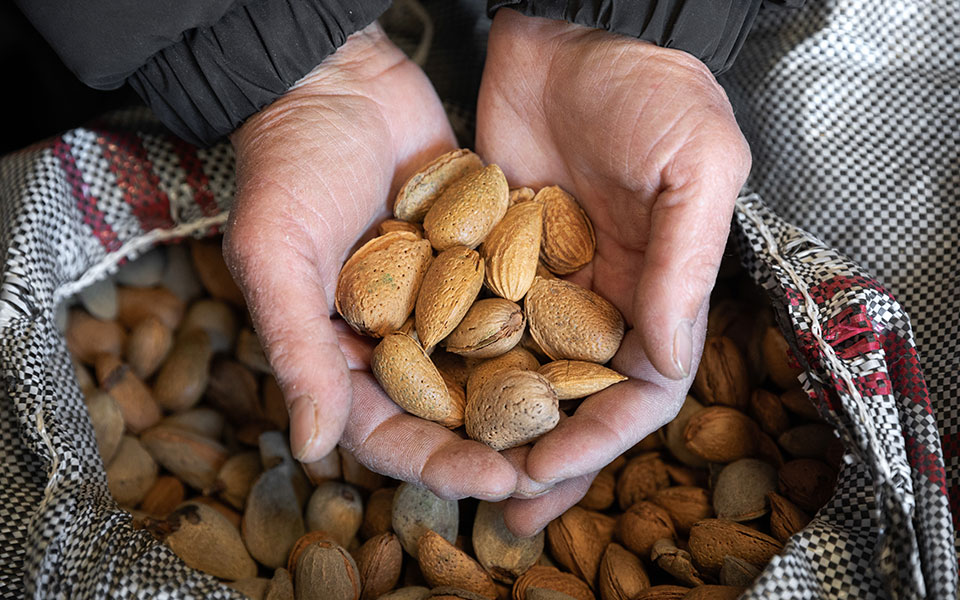
© Konstantinos Tsakalidis/SOOC
As he stands before piles of five-kilo sacks left over from the previous harvest – half is usually sold during Christmas and the rest is distributed on demand – he selects different almonds and explains the characteristics of each variety. Truito almonds are very hard, Texas almonds are the most aromatic and thus preferred for kourabiedes (almond butter cookies), Ferragnes almonds have the most oblong shape and thus are ideal for roasting, while Feranduela almonds are used to fertilize the Ferragnes variety.
In general, the almond life cycle is mostly the same, no matter the variety. The trees are pruned in November-December, are fertilized in February, while they blossom in early spring and about 20 days after the petals fall, the drupe begin to grow. From around 20 June the kernel of the nut develops, until September, when the harvest begins by shaking the nuts off the branches using big sticks, or machines that shake the tree. Finally, the almonds are dried mechanically, in special ovens.
“In the past, we lay the almonds in the sun to dry, and we would run to cover them up as soon as we saw clouds in the sky,” Giorgos describes, relieved that he no longer has to endure this anxiety during the night and can now sleep in peace.
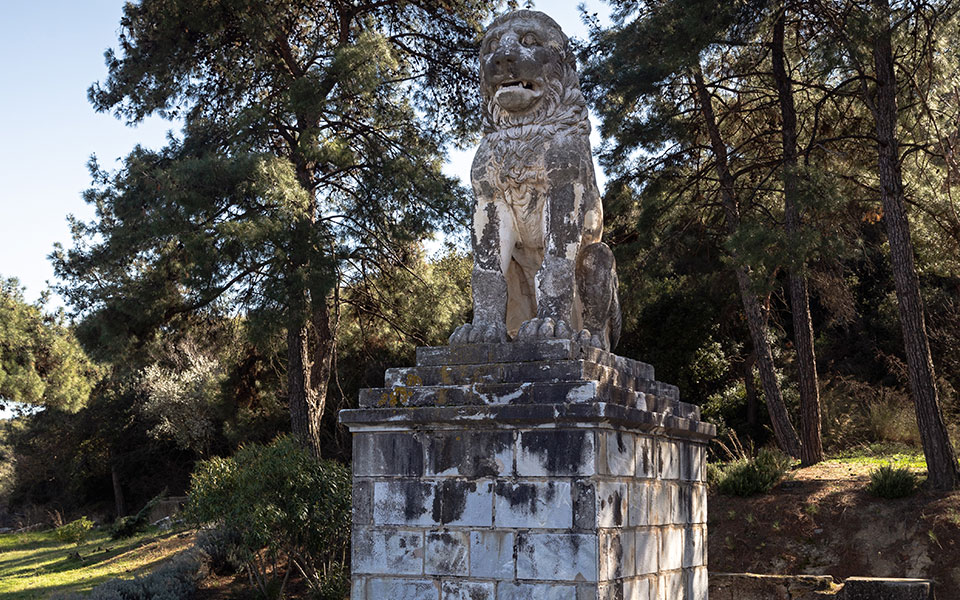
© Konstantinos Tsakalidis/SOOC
HISTORIC PLACE
The Lion of Amphipolis
During our tour with Giorgos Epitropou, which took us to Touzla, the coastal area of Ofrynio that bustles with life as tourists from the Balkans flock here every summer, he told us about the unbridled rate of development this region has undergone over time. In his memories, however, we discerned a common denominator: the love of almonds. The almond trees that he grew up with on this land, whose history he wanted to narrate over a glass of tsipouro, something the pandemic denied us.
He may not have filled our glasses, but he was able to fill us with joy by taking us to visit the “lion.” Next to the old Strymonas bridge proudly stands the Lion of Amphipolis, a funerary monument from the 4th century BC erected in honor of General Laomedon of Mytilene, a devoted confidante of Alexander the Great.
Ofrynio is located 56km from Kavala, 104km from Thessaloniki and 604km from Athens.
This article was first published in Greek on kathimerini.gr

